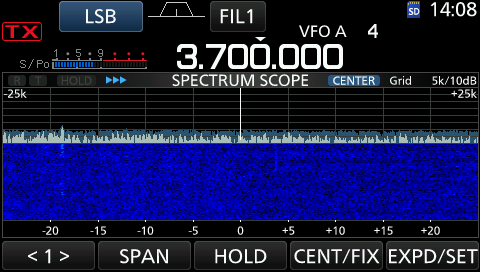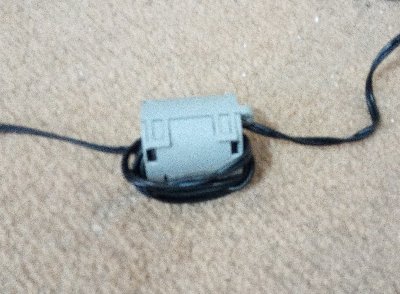RFI Investigation At My
QTH
09.01.18

It was not until my good radio friend Geoff, G0LUJ, began
experimenting with remote reception that I became fully aware of
just how bad HF RX degradation had become here. I live in the
suburbs so I do not expect to be able to hear as well as Geoff's
Kiwi station (See here,
but be prepared to be depressed when you return to your own
receiver unless you too live in the wilds). However I had always
been able to receive stations on 80m, though it seemed to me
they had once been much clearer. After much procrastination I
decided to find out what, if anything, I can do to improve
things here. The results are mixed news.
Method (V Madness)
I decided to begin with what I could control. That would
probably be also where it would have to end. We have to face it,
radio amateurs are becoming an anachronism - 'lame', my kids
call the hobby, HI. Harmless eccentrics at best, or easy
scapegoats for technical ignorance 'that bloke with the CB
aerials who makes my phone not work!' at worst. I also wanted to
keep the costs down. Fortunately I already have an Icom 7300
with its wide view of the spectrum. I had an old camcorder. I
made short videos at 1mhz intervals from 0-30mhz of the noise.
After fitting a 5ah gel battery to the IC7300 and then, knowing
it would screw up half the appliances in the house, I turned off
the mains. I have tried isolating circuits and seeing if it made
any difference to no avail. I suspected there would always be
something I had missed - and it did turn out that way - so a
drastic Zero Power test seemed in order.
I then repeated the videos at 1mhz intervals. The antenna is
just a 25m inverted L against a ground system, hardly the
'quietest' antenna but one suitable for relative comparisons.
Measurements
I have not as yet analysed each video, on each mhz, against each
other. I do not really need to. What I noticed was pretty clear
and it is a mixed message shouting back at me. On the lower HF
bands, below 10mhz, much of the RFI is generated when our house
is powered up - S9+ noise dropped to about S5 when I tripped the
mains. Doubtless some of it is our VDSL modem, but it was NOT
the main culprit. One source, at lower HF, was immediately
isolated and resolved. The RFI from 8-30mhz is widespread,
pulsing and very hard to ignore - even my Red Pitaya doesn't
pull much out on 10mhz any more. That noise was present during
power down. It would appear I shall have to put up with it.
Subsequent Action
I was almost immediately able to identify the (lower HF RFI)
source as a single switch mode power supply. I had changed this
before, and I was certain it was quiet. This test revealed it
was not. A single ferrite core sorted it out. I now have
reasonable reception below 10mhz once more - average S5+ noise
as opposed to S9+ before suppression: chalk v cheese in terms of
listening). Nothing like Geoff's remote station, but useable.
For this alone, all that resetting of appliances I am about to
begin is worthwhile.


Without v With Choke

Simple choke
These images are from the noisier part of the day, nevertheless
reception is much improved.
It is not such good news above 10mhz. Whatever it is that wipes
out vast swathes of the upper HF bands does not originate from
G0MJI.
Conclusion
Before blaming others look to the mote in thine own eye! I am
really pleased to have the lower HF bands once more. Then I
guess it is a case of being realistic. If you cannot afford to
relocate to a deserted island perhaps make the most of what you
have. The IC7300, any SDR in fact, is very good for identifying
'windows' in the noise, as well as for recording and monitoring
the RFI environment. For instance perhaps is is no coincidence
that both (harmonically related) 10mhz and 20mhz are wiped right
out here. It could be one piece of dodgy equipment located
nearby, perhaps one day it will be removed and the problem along
with it. It is just as likely to be replaced/added to by another
source. I suppose frequent scans of the bands could be useful in
this regard. As I listen to 80m even as I type I can hear a qso
about RFI. I am not alone. I concur with the sentiment expressed
on there (synchronicitously): where it is noisy use the internet
stations for RX. And those people who spend many hours and
pounds setting up/running remote stations, for the benefit of
those of us with noisy QTHs, should be thanked. So, thank you
G0LUJ.
Note
It was apparent that the noise above 10mhz is quite wideband and
varied from S9+20db hash to almost ignition pulse type. At least
so it appeared between amateur segments ** (See Extra Note
below). The IC7300 is of course an amateur band transceiver with
wideband receive. When tuned to the amateur bands the extra
selectivity of the filtering deployed here was clear, and not just
in relay clicks - the noise dropped markedly. So that although it
might be exceedingly noisy either side of a particular amateur
band, it was sometimes quieter within, say, the 15m band. (Hmm,
see below)

Look at the 15m Amateur Filter Window
This led me to consider that at least some of the
'interference' is strong, localised and breaking through (from
other frequencies) the lesser defences of the IC7300 in what
might be called comms receiver mode rather than actually on
that 'apparent' frequency. The one amateur band which retained
its interference was 10mhz. Which leads me to think that on
10mhz (at the very least) the signal is genuine RFI. Of course
the filtering allows for amateur band windows, if not on 10mhz
presently. This may explain the absolute dearth of Wspr spots
on 30m at G0MJI over the past couple of years i.e. at least
some of this RFI is spot on the 10mhz band, no filtering can
defend against a signal that is actually there. As to what the
source of the RFI may be, who knows? VDSL at the neighbours?
Something to ponder...
Extra (Extra, Read All About
It)
Note
Geoff has been in
touch and correctly identified the interference in the
final picture as caused by powerline ethernet adapters. He
tells me these have 'windows' for the amateur bands
designed into them (thus dismissing my filter theory) and
the type of noise is consistent with their variations in
transfer of data.
I suspect that when I do get round to analysing the
videos this component of RFI will be missing in the
powered down videos - More progress! He further
suggests, as I
also suspect, that the 8-13mhz noise is VDSL. As this is present even
when my own router is completely powered down (the
whole house in fact), then I suspect there is little
to be done, although I did contribute to the RSGB
VDSL Survey
last year. I shall ponder and look more closely at the
videos soon...
Meantime I am off to have a listen around on the
'restored' 80/60/40m bands.
Happy listening!
PS The Plot Thickens
Well I had considered rewriting this whole thing.
New findings change the picture each time. However
these are my notes and so I will leave the
saga as it is. Perhaps the twists are all part of such
an investigation. It turns out the Mains Ethernet
Adapter (PLT) interference, which is quite distinctive
on an SDR screen does NOT originate at my QTH. Here is
an image of the 21mhz band with no mains electricity
at my QTH - hence the dark and blurry screenshot.
(Note time is 9.02 when the mains was cut off here).
This 'Smart Notching' as described by Ofcom in the
document below is clearly visible in this image as
well as the one above.

Mains Off, PLT Noise
Here is an Ofcom document. Although published
in 2009 it
remains both prophetic
and relevant. It states
somewhere inside of it that these PLT devices can radiate
up to 300m. So it looks like the PLT noise experienced
here originates from a neighbouring property. It seems
unlikely I can do anything about this, even if I knew
which property.

Typical PLT Device
Final Conclusion (For Now...)
24 hours ago I powered down the house. There are many
devices which do not like this, gone are the days of 70s
power cuts - long gone now I think about it. It is a bit
of a nuisance to restore everything, but well worth it if
you are willing to take the risk - your responsibility. It
seems to me this is the only way to establish a definitive
baseline of the RFI from the surrounding environment. I
discovered quite quickly that the main source of
irritation was a single 1amp switch mode power supply I
had thought clean. I used a choke to sort that out, and
today I replaced it with a linear psu - I am listening to
80m as I type. So that was a good result from the point of
view of lower HF reception. It is good to have those bands
back.
There are two further sources of local RFI (at least):
VDSL from 8-13+mhz and pulsed wideband noise from PLT
devices up to 30mhz (either via 'infected' powerline, or
house wire radiation). These overlap and appear right the
way from 8-30mhz at least. Thanks to Geoff's experience I
have been able to untangle these sources one from another.
Unfortunately it seems these two sources cannot be
tackled. Furthermore as new people move into the area then
it is likely this situation may deteriorate further. At
least I have a baseline for comparison, as well as an
improved knowledge of what to look for.
As always this 'final' conclusion is subject to revision -
repeat these tests at your own risk.
Further Thoughts:
Since identifying some of the noise as PLT based further
research revealed that the ignition type component of PLT
is symptomatic of BT Vision television distribution. There
is no such system in my QTH. I strongly suspect one of my
neighbours has installed this. See this
document for more information. It also suggests an
explanation for the RFI noticed on MW broadcast bands at
this location, which precipitated a move to DAB some years
ago. I do not want to go door-to-door until the 'culprit'
is identified. I doubt the innocent party would
understand.







